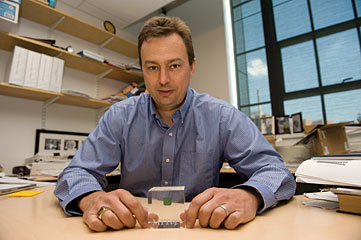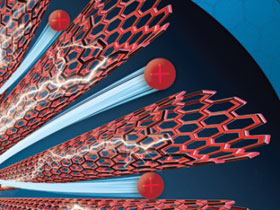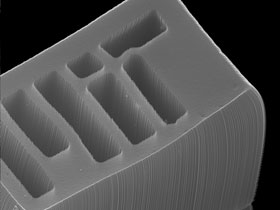AeroAstro Magazine Highlight
The following article appears in the 2009–2010 issue of AeroAstro, the annual report/magazine of the MIT Aeronautics and Astronautics Department. © 2010 Massachusetts Institute of Technology.
ENERGY AND ENVIRONMENTAL FOCUS PERVADES AEROASTRO MATERIALS RESEARCH
By Brian L. Wardle
In 2005, MIT President Susan Hockfield announced her Institute-wide energy initiative, saying, "tackling the problems that energy and the environment present will require contributions from all our departments and schools ... bringing scientists, engineers and social scientists together to envision the best energy policies for the future."
Professor Brian Wardle holds a plastic block in which is embedded a microchemical fuel cell developed in his lab. The device, designed for the Army as a replacement for batteries, was encapsulated and presented as a memento to the MIT Energy Initiative's founding board members. (William Litant/MIT photo) |
 |
While President Hockfield's announcement marked an MIT-wide coordinated interdisciplinary energy-related research effort, a number of MIT researchers were already hard at work examining energy issues. Energy and environmental topics pervade much of the research done on the MIT campus, including that done by my research group.
At the time of the MIT Energy Initiative (MITEI) launch, I was the materials and structures lead for an Army-sponsored large multidisciplinary project focused on technologies to replace batteries: we were working on a miniature microchemical fuel cell built using ultra thin-films (1/1000 the thickness of a human hair) of materials. President Hockfield presented each of MITEI's founding board members with a memento symbolic of the energy-related work MITEI would pursue. Each person was presented a display block in which was encapsulated a fuel cell fabricated by my student Namiko Yamamoto during her AeroAstro SM thesis. It is a very high-temperature (>600°C) micro-device using highly nontraditional (and nano-scale) materials that we designed, developed the processing to build, and then tested. Because the devices were built on a microelectronics/MEMS platform, thousands were created at one time, making it both scalable and a convenient gift item.
My active research includes several examples of energy and environment-related activities:
- Green carbon nanotubes: A key element in the majority of my current research involves a special arrangement of carbon atoms that create hollow graphitic tubes, or carbon nanotubes (CNTs). CNTs are the world's latest supermaterial, with many properties that exceed other known materials, and applications that range from microelectronics to space construction materials. Processes for growing CNTs are numerous, but all involve high temperatures and chemical reactions whose mechanisms are only partially understood. Many of the routes by which CNTs are manufactured involve dangerous and toxic inputs and byproducts. A key initiative led by recent MIT graduate and current visiting professor in my group, Dr. Desiree Plata, is to make the synthesis of CNTs more efficient and environmentally friendly. Professor Plata and I believe that keeping a focus on developing clean and responsible manufacturing is a key element for the long-term success of this important material. Related work in this area focuses on new catalyst seeds for growing the CNTs without using problematic metals, a new program sponsored by the National Science Foundation.
- Materials for efficient transportation: The core of my work is developing more advanced composites using nano-engineered materials for aerospace applications, work largely funded by industry through the Nano-Engineered Composite aerospace STructures (NECST) Consortium that I lead. Materials Energy and environmental focus pervades MIT materials research with advanced capabilities can directly reduce vehicle weight, and multifunctionality can replace dedicated systems with structures that can do more, such as self-sense for damage, and de-ice without heaters (e.g., where the composite structure serves as the heater). Much of the efficiency of new commercial composite aircraft comes from the use of traditional advanced composites and billions of dollars in lifetime cost savings is expected. Next-generation composites that NECST is developing would further enhance aircraft efficiency and what we learn may be transferable to other materials applications in transportation and building infrastructure.

|
Ion-conducting polymer "expressways" are created between highly conductive aligned carbon nanotubes in the recently demonstrated hybrid electrodes for ionic actuators and energy harvesters. The "plus" ions are driven up and down the channels between the carbon nanotubes, which are filled with polymer, yielding near-optimal theoretical performance. |
- Environmental health of nanomaterials: My group synthesizes and works with nanomaterials on a daily basis. We are concerned and conscious of environmental health and safety concerns and proper procedures for working with the materials in a laboratory setting. However, in understanding the issues for our work, we have found that the current state of understanding nanomaterials' health effects is nascent at best. We have opened our lab and processes to external researcher Professor Dhimiter Bello, from Occupational Hygiene and Work Environment Chemistry at UMass-Lowell, who, in collaboration with MIT's Environmental Health and Safety Office, is helping us better understand exposure. What we have learned has been shared through several nanoparticle exposure journal articles. We are posing questions such as: "what happens when you make a new material containing CNTs and then you need to do something simple like machine it?" Traditional tooling for composites is abrasive and creates a lot of dust. So, what is in the dust when carbon nanotubes are in the composites?
- Pervasive energy for ubiquitous sensors. Microdevice sensors, such as those that can be distributed over large areas for infrastructure monitoring and threat detection, need power, and neither solar nor batteries are practical due to desired lifetime and operational restrictions. A continuing effort in my research group is to use small mechanical vibrations to generate electrical power using piezoelectric materials. These vibrations are ubiquitous in the environment: they emanate from sources such as the wind, motion of people, and operation of machinery. Vibrations in cars and airplanes that are bothersome to passengers are power to be harvested. Piezoelectrics are intrinsically electromechanically coupled, and, therefore, can be used to power devices from these vibrations. We have focused on optimal design for power extraction and have built devices based on our models, which show that there are many applications where such energy harvesting is both practical and advantaged.
Aligned carbon nanotubes are organized as an MIT logo via photolithography and then grown in Wardle's lab. The aligned CNT "forest" appears optically and under scanning electron microscopy (as in the image) as black and solid, however, it is more than 99 percent air by volume. Aligned CNT forests like this are used in Wardle's energy storage and composite research. |

|
- Novel energy harvester electrodes: Recently, my group collaborated to create the highest performing electrodes for a class of energy harvesters (and actuators) called ionic polymer actuators. We applied what we have learned from our work in composites and processing of nanomaterials, especially CNTs and polymers, and designed superior electrodes. In these devices, the limiting feature for efficiency and speed is how quickly ions move inside the electrodes. By creating aligned nanoscale channels between highly electrically conductive CNTs, we create "express lanes" for the ions to travel up and down. The devices can be run as energy harvesters or in the reverse as actuators, and have applications in harvesting energy from low-frequency high-amplitude sources such as waves in the ocean. This work is in collaboration with Professor Qiming Zhang's group at the Pennsylvania State University.
Some might think it a bit strange that a group from AeroAstro — in fact a group and a laboratory that works primarily on advanced materials and composites for aerospace applications — would contribute the energy souvenir for MITEI at its founding. However, this simply reflects the fact that in aerospace, energy efficiency has always been a critical concern.
 Brian L. Wardle is an associate professor of aeronautics and astronautics at MIT where his work focuses on materials and structures. He pursues research in nano-engineered advanced composites, traditional composites, bulk nanostructured materials, power-MEMS devices (fuel cells and vibrational energy harvesters), and other structures and materials topics. Wardle is founder and director of MIT's Nano-Engineered Composite aerospace STructures Consortium. He is a principal member of the Technology Laboratory for Advanced Materials and Structures, and is active in the Microsystems Technology Laboratory and Materials Processing Center communities. He may be reached at wardle@mit.edu.
Brian L. Wardle is an associate professor of aeronautics and astronautics at MIT where his work focuses on materials and structures. He pursues research in nano-engineered advanced composites, traditional composites, bulk nanostructured materials, power-MEMS devices (fuel cells and vibrational energy harvesters), and other structures and materials topics. Wardle is founder and director of MIT's Nano-Engineered Composite aerospace STructures Consortium. He is a principal member of the Technology Laboratory for Advanced Materials and Structures, and is active in the Microsystems Technology Laboratory and Materials Processing Center communities. He may be reached at wardle@mit.edu.